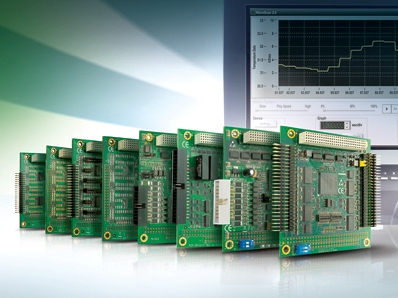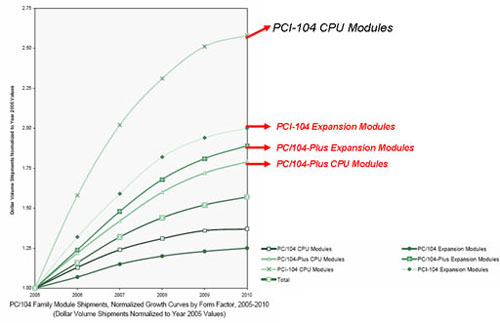| |
Exploring PCI-104 Modules

|
PC/104 is an embedded computer standard which defines both a form factor and computer bus. The PC/104 form factor was originally devised by Ampro Computers in 1987, and later standardized by the PC/104 Consortium in 1992. By standardizing the hardware, embedded system designers can substantially reduce development costs, risks, and time. This means faster time-to-market and the ability to hit critical market windows with timely product introductions.
Choices, Choices
The two most common form factors defined by this standard include the PC/104 and the PCI-104. The PCI-104 form factor includes the PCI connector, but not the ISA connector, in order to increase the available board real estate. Based upon market research provided by VDC, 25% of the market currently uses PC/104, while 40% uses PCI-104. Each form factor will keep the same ratio share until at least 2010.
PC/104 vs. PCI-104
While similar, these two form factors are actually competing with each other. PCI-104 is considered the next generation of PC/104, and though the PCI-104 has a much higher throughput, many users do not feel an urgent need to upgrade. If their systems are meeting the need for their applications, after all, there may be no need.
One limitation of PCI-104 of course is that it only permits four PCI cards along a bus segment without a bridge. In contrast, the ISA-based PC/104 has no specific limit to slot count, although typically no more than six cards are stacked together. However, the common ideology is that the march of technology is inevitable, and PCI-104 is believed to be the future trend.
|

|
Looking Ahead
Like PC/104, PCI-104 is an open standard. The features of PCI-104 compared to PC/104 include more I/O's, higher resolution, and a higher base clock speed.
Advantech’s PCM-3614I, PCM-3618I, PCM-3641I, PCM-3642I, PCM-3730I, PCM-3753I, PCM-3761I, PCM-3813I, and PCM-3810I meet the demands of fast-growing embedded applications. The PCM-3600I series offers a choice of 4 or 8 asynchronous RS-232/RS-422/RS-485 serial ports for a PCI-104 bus. It enables embedded systems or thin clients with the ability to communicate to RS-232 or RS-232/422/485 serial peripherals. The plug and play capability of this PCI-104 solution is perfect for instrumentation and point-of-sale applications. Serial port connections are made via included cables, providing DB-9 female connectors. This PCI plug and play function allows easy serial port expansion that requires no IRQ, DMA, or I/O address resources. Users are no longer to set the jumpers and switches and could also save on setup time and cost considerably.
PCM-3730I features 32-ch isolated digital I/O (16 inputs and 16 outputs) with high voltage isolation up to 2,500 VDC. PCM-3753I includes 96-ch bi-directional 5V/TTL digital I/O for high density usage. PCM-3761I has 8 Form C type relays and 8 isolated digital input channels. PCM-3813I is an isolated analog input module with 100 kS/s (sampling rate), 12-bit (resolution), and 32-ch (channel). PCM-3810I. 250 kS/s, 12-bit, 16-ch Multifunction PCI-104 Module, possesses the highest sampling rate among all of Advantech’s PC/104 modules and supports many advanced trigger modes. They are ideal for embedded automation applications.
CAN Bus Modules
CAN is an abbreviation of Control Area Network, which is a serial bus system especially suited for networking ‘intelligent’ I/O devices as well as sensors within a machine. Characterized by its multi-master protocol, real-time capability, error correction, high noise immunity, and the existence of many different silicon components, the CAN serial bus system, originally developed by Bosch for use in automobiles, is increasingly being used in industrial automation.
Like PCM-3680, PCM-3680I, built-in CAN controllers provide bus arbitration and error detection with automatic transmission repeat function, drastically avoiding data loss and ensuring system reliability. The onboard CAN controllers are located at different positions in the memory; thus, users can run both CAN controllers simultaneously and independently.
PCM-3680I, as well as PCM-3680, can also support wide temperature operation, so the temperature range can expand to -40 ~ 85° C, resisting the harshest industrial environments. |
 |
|
Copyright © 1983-2010 Advantech Co., Ltd. All Rights Reserved. |
|